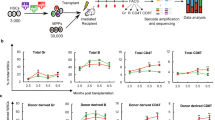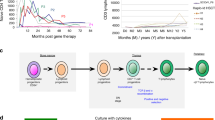Abstract
The identification of human CD34-negative (CD34−) hematopoietic stem cells (HSCs) provides a new concept for the hierarchy in the human HSC compartment. This study investigated the long-term repopulating capacity and redistribution kinetics of human cord blood-derived CD34− severe combined immunodeficiency (SCID)-repopulating cells (SRCs) and compared them with those of CD34+CD38+ and CD34+CD38− SRCs using the intra-bone marrow injection (IBMI) to clarify the characteristics of CD34− SRCs. On the basis of the limiting dilution analyses data, estimated numbers of CD34+CD38+, CD34+CD38−, and CD34− SRCs were transplanted to NOD/SCID mice by IBMI. The human cell repopulation at the site of injection and the other bones were serially investigated. Interestingly, CD34+CD38+, CD34+CD38−, and CD34− SRCs began to migrate to other bones 2 and 5 weeks after the transplantation, respectively. Accordingly, the initiation of migration seemed to differ between the CD34+ and CD34− SRCs. In addition, CD34+CD38+ SRCs only sustained a short-term repopulation. However, both CD34+CD38− and CD34− SRCs had longer-term repopulation capacity. Taken together, these findings showed that CD34− SRCs show different in vivo kinetics, thus suggesting that the identified CD34− SRCs are a distinct class of primitive HSCs in comparison to the CD34+CD38+ and CD34+CD38− SRCs.
This is a preview of subscription content, access via your institution
Access options
Subscribe to this journal
Receive 12 print issues and online access
$259.00 per year
only $21.58 per issue
Buy this article
- Purchase on Springer Link
- Instant access to full article PDF
Prices may be subject to local taxes which are calculated during checkout





Similar content being viewed by others
References
Dick JE . Normal and luekemic human stem cells assayed in SCID mice. Semin Immunol 1996; 8: 197–206.
Larochelle A, Vormoor J, Hanenberg H, Wang JCY, Bhatia M, Lapidot T et al. Identification of primitive human hematopoietic cells capable of repopulating NOD/SCID mouse bone marrow: implications for gene therapy. Nat Med 1996; 2: 1329–1337.
Bhatia M, Wang JCY, Kapp U, Bonnet D, Dick JE . Purification of primitive human hematopoietic cells capable of repopulating immune-defficient mice. Proc Natl Acad Sci USA 1997; 94: 5320–5325.
Bhatia M, Bonnet D, Murdoch B, Gan OI, Dick JE . A newly discovered class of human hematopoietic cells with SCID-repopulating activity. Nat Med 1998; 4: 1038–1045.
Wang JCY, Doedens M, Dick JE . Primitive human hematopoietic cells are enriched in cord blood compared with adult bone marrow or mobilized peripheral blood as measured by quantitative in vivo SCID-repopulating cell assay. Blood 1997; 89: 3919–3924.
Kim DK, Fujiki Y, Fukushima T, Ema H, Shibuya A, Nakauchi H . Comparison of hematopoietic activities of human bone marrow and umbilical cord blood CD34 positive and negative cells. Stem Cells 1999; 17: 286–294.
Wang J, Kimura T, Asada R, Harada S, Yokota S, Kawamoto Y et al. SCID-repopulating cell activity of human cord blood-derived CD34- cells assured by intra-bone marrow injection. Blood 2003; 101: 2924–2931.
Kimura T, Wang J, Matsui K, Imai S, Yokoyama S, Nishikawa M et al. Proliferative and migratory potentials of human cord blood-derived CD34− severe combined immunodeficiency repopulating cells that retain secondary reconstituting capacity. Int J Hematol 2004; 79: 328–333.
Kimura T, Asada R, Wang J, Kimura T, Morioka M, Matsui K et al. Identification of long-term repopulating potential of human cord blood-derived CD34−flt3− severe combined immunodeficiency-repopulating cells by intra-bone marrow injection. Stem Cells 2007; 25: 1348–1355.
Sonoda Y . Immunophenotype and functional characteristics of human primitive CD34-negative hematopoietic stem cells: the significance of the intra-bone marrow injection. J Autoimmunity 2008; 30: 136–144.
Hogan CJ, Shpall EJ, Keller G . Differential long-term and multilineage engraftment potential from subfractions of human CD34+ cord blood cells transplanted into NOD/SCID mice. Proc Natl Acad Sci USA 2002; 99: 413–418.
Ito M, Hiramatsu H, Kobayashi K, Suzue K, Kawahata M, Hioki K et al. NOD/SCID/γcnull mouse: an excellent recipient mouse model for engraftment of human cells. Blood 2002; 100: 3175–3182.
Kimura T, Minamiguchi H, Wang J, Kaneko H, Nakagawa H, Fujii H et al. Impaired stem cell function of CD34+ cells selected by two different immunomagnetic beads systems. Leukemia 2004; 18: 566–574.
Porter EH, Berry RJ . The efficient design of transplantable tumor assays. Br J Cancer 1964; 17: 583–595.
Taswell C . Limiting dilution assays for the determination of immunocompetent cell frequencies. I. Data analysis. J Immunol 1981; 126: 1614–1619.
Yahata T, Ando K, Sato T, Miyatake H, Nakamura Y, Muguruma Y et al. A highly sensitive strategy for scid-repopulating cell assay by direct injection of primitive human hematopoietic cells into NOD/SCID mice bone marrow. Blood 2003; 101: 2905–2913.
McKenzie JL, Takenaka K, Gan OI, Doedens M, Dick JE . Low rhodamine 123 retention identifies long-term human hematopoietic stem cells within the Lin-CD34+CD38− population. Blood 2007; 109: 543–545.
Guenechea G, Gan OI, Dorrell C, Dick JE . Distinct classes of human stem cells that differ in proliferative and self-renewal potential. Nat Immunol 2001; 2: 75–82.
Mazurier F, Gan OI, McKenzie JL, Doedens M, Dick JE . Lentivector-mediated clonal tracking reveals intrinsic heterogeneity in the human hematopoietic stem cell compartment and culture-induced stem cell impairment. Blood 2004; 103: 545–552.
Yahata T, Yumino S, Seng Y, Miyatake H, Uno T, Muguruma Y et al. Clonal analysis of thymus-repopulating cells presents direct evidence for self-renewal division of human hematopoietic cells. Blood 2006; 108: 2446–2454.
McKenzie JL, Gan OI, Doedens M, Wang JCY, Dick JE . Individual stem cells with highly variable proliferation and self-renewal properties comprise the human hematopoietic stem cell compartment. Nat Immunol 2006; 7: 1225–1233.
Yahata T, Muguruma Y, Yumino S, Sheng Y, Uno T, Matsuzawa H et al. Quiescent human hematopoietic stem cells in the bone marrow niches organize the hierarchical structure of hemtopoiesis. Stem Cells 2008; 26: 3228–3236.
Wright DE, Bowman EP, Wagers AJ, Butcher EC, Weissman IL . Hematopoietic stem cells are uniquely selective in their migratory response to chemokines. J Exp Med 2002; 195: 1145–1154.
Peled A, Petit I, Kollet O, Magid M, Ponomaryov T, Byk T et al. Dependence of human stem cell engraftment and repopulation of NOD/SCID mice on CXCR4. Science 1999; 283: 845–848.
Osawa M, Hanada K, Hamada H, Nakauchi H . Long-term lymphohematopoietic reconstitution by a single CD34-low/negative hematopoietic cell. Science 1996; 273: 242–245.
Ogawa M . Changing phenotypes of hematopoietic stem cells. Exp Hematol 2002; 30: 3–6.
Zanjani ED, Almeida-Porada G, Livingston AG, Zeng H-Q, Ogawa M . Reversible expression of CD34 by adult human bone marrow long-term engrafting hematopoietic stem cells. Exp Hematol 2003; 31: 406–412.
Dao MA, Arevalo J, Nolta JA . Reversibility of CD34 expression on human hematopoietic stem cells that retain the capacity for secondary reconstitution. Blood 2003; 101: 112–118.
Nakamura Y, Yahata T, Muguruma Y, Uno T, Sato T, Matsuzawa H et al. Angiopoietin-1 supports induction of hematopoietic activity in human CD34− bone marrow cells. Exp Hematol 2007; 35: 1872–1883.
Acknowledgements
This work was supported by Grants-in-Aid for Scientific Research C (grant Nos. 19591144 and 21591251) from the Ministry of Education, Science and Culture of Japan, a grant from Haiteku Research Center of the Ministry of Education, a grant from the Science Frontier Program of the Ministry of Education, a grant from the 21st Century Center of Excellence (COE) program of the Ministry of Education, a grant from the Promotion and Mutual Aid Corporation for Private Schools of Japan, a grant from Kansai Medical University (Research grant B), a grant from the Japan Leukemia Research Foundation, a grant from the Mitsubishi Pharma Research Foundation, and a grant from the Takeda Science Foundation.
Author information
Authors and Affiliations
Corresponding author
Additional information
Supplementary Information accompanies the paper on the Leukemia website (http://www.nature.com/leu)
Rights and permissions
About this article
Cite this article
Kimura, T., Matsuoka, Y., Murakami, M. et al. In vivo dynamics of human cord blood-derived CD34− SCID-repopulating cells using intra-bone marrow injection. Leukemia 24, 162–168 (2010). https://doi.org/10.1038/leu.2009.206
Received:
Revised:
Accepted:
Published:
Issue Date:
DOI: https://doi.org/10.1038/leu.2009.206
Keywords
This article is cited by
-
A revised road map for the commitment of human cord blood CD34-negative hematopoietic stem cells
Nature Communications (2018)
-
The number of CD34+CD133+ hematopoietic stem cells residing in umbilical cord blood (UCB) units is not correlated with the numbers of total nucleated cells and CD34+ cells: a possible new indicator for quality evaluation of UCB units
International Journal of Hematology (2018)
-
CD34-negative hematopoietic stem cells show distinct expression profiles of homing molecules that limit engraftment in mice and sheep
International Journal of Hematology (2017)
-
Human cord blood-derived primitive CD34-negative hematopoietic stem cells (HSCs) are myeloid-biased long-term repopulating HSCs
Blood Cancer Journal (2015)
-
CD133 is a positive marker for a distinct class of primitive human cord blood-derived CD34-negative hematopoietic stem cells
Leukemia (2014)



